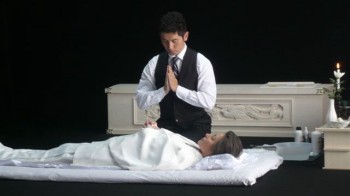Films should be about quality / TV stations' involvement double-edged sword for movie industry
Yoshikazu Suzuki / Yomiuri Shimbun Senior Writer
The growing role TV stations are taking in financing and producing movies, along with TV programs, is a double-edged sword.
On one hand, the linkage between programs and movies made under the support of TV stations has produced a number of hit motion pictures and contributed to the nation's filmmaking industry. On the other, box-office takings and moviegoers have been polarized, which threatens the diversity of our movie-making culture. Take, for example, "Akai Ito" (Red Thread), which started as a romantic novel published on a cell phone Web site. At the end of last year, it was reincarnated as a serial drama on Fuji TV and released as a movie aimed at middle and high school students when the winter holidays began. "The film crew and the staff were exactly the same," said Chihiro Kameyama, chief of the station's motion picture unit. "The footage was edited separately, which was a new, more efficient way of doing it." The movie was a huge success raking in more than 1.1 billion yen at the box office.
The third-highest grossing Japanese movie in 2008 was "Yogisha X no Kenshin" (The Devotion of Suspect X), a cinematic adaptation of the popular serial drama "Galileo." On the day the movie opened, Fuji TV broadcast a drama depicting the early life of the main character in the movie. The ratings were excellent.
And on the day the police thriller "Daremo Mamotte Kurenai" (Nobody to Watch Over Me) arrived on the silver screen, the same station aired a show "Daremo Mamorenai" (Nobody Can Watch Over Me) featuring the same cast.
The end of the two-hour drama featured the opening scene of the movie. Some cynics might suggest the TV program had been little more than an extended trailer for the movie.
But Fuji is not the only station making TV programs to coincide with movies it has produced or helped produce. In December, NTV showed "episode ZERO" of "252 Seizonsha Ari" (252 Survivors) the night before the release of the movie, and last month, a special edition of the first installment of the "20th Century Boys" was aired the evening before the second installment of the trilogy hit the big screen.
"The TV version of '20th Century Boys' has now been completed," executive producer Seiji Okuda said. "I'm sure people who've seen the film, and even those who haven't, would enjoy it."
TV stations' strategy to produce hit movies was established by Fuji TV in its "Odoru Dai-sosasen" series. A movie version of the police drama became a big hit in 1998, the year after the first series aired on TV.
Its sequel, released in 2003, saw excellent box office returns of 17.35 billion yen.
One reason TV stations have actively engaged in producing movies is a management policy of increasing revenue from sources other than advertisements because sponsor TV ad budgets are not expected to further increase.
Last year, the top 10 hit Japanese movies in terms of box office revenue, which accounted for about 60 percent of the 194.8 billion yen in total domestic theatrical release sales, were dominated by works produced by TV stations.
TV stations have undoubtedly contributed to the nation's movie industry. However, the 28 titles that earned 1 billion yen or more at the box office accounted for nearly three-quarters of the total sales of the 418 Japanese movies released last year.
The movie market did not grow from the previous year, so the small slice of the remaining box office sales was shared by the hundreds of other movies.
It is also a concern that none of the high-quality movies chosen as the best 10 by Kinema Junpo movie magazine, including "Okuribito" (Departures), which won an Oscar this week as Best Foreign Language Film and many other prizes at home and abroad, did not make the list of top 10 box office earners.
Prof. Kenzo Horikoshi at the Graduate School of Film and New Media of the Tokyo University of the Arts pointed out that moviegoers are polarized.
"Young people see movies that are mass-advertised in many cases. The films that get excellent reviews are patronized by middle-aged and elderly people," he said.
He voiced concern about the current trend, saying: "Movie projects led by TV stations give priority to casting, with the talent or characteristics of directors tending to be given short shrift. If the TV dramas' production styles are the only ones that gain popularity, the unique and diversified culture of cinema could wane."
An official of a TV station had an even more pessimistic view.
"Now that tie-ups with TV programs have become this popular, moviegoers may get fed up," the official said.
Horikoshi added: "However well-organized the TV programs may be, they are produced only to advertise the movies. Can TV stations say it's fair competition when they are using public airwaves?"
In France, the government asks TV stations only to invest in movies to support the movie industry, while regulating movie production under the initiative of TV stations.
It's desirable that there are excellent movies that remain in people's memories for many years, as well as record-setting hit films.
TV stations may need to contribute to raising the quality level of Japanese movies-not only to produce hits that get the theater tills ringing-like TBS, which helped finance the production of "Okuribito."
(Feb. 28, 2009)

